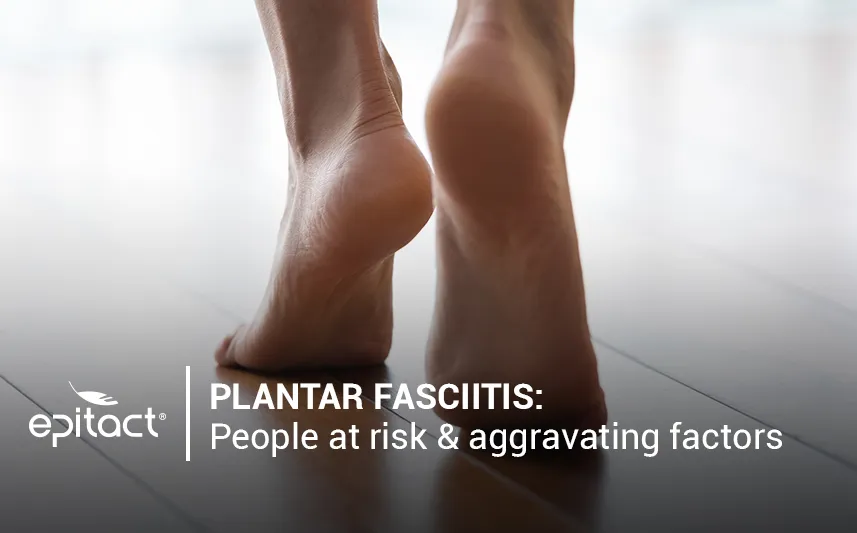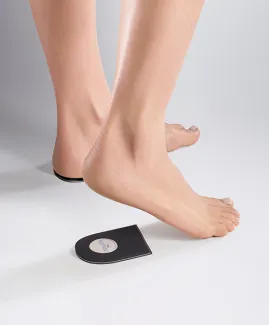
Heel spurs and plantar fasciitis cause intense pain in the heel, which is particularly disabling. Even if pain perception is variable from one person to another, are we all equally likely to develop plantar fasciitis? Are there people who get plantar fasciitis easier than others? Let’s discover how you get plantar fasciitis based on a list of major risk factors detailed by EPITACT®.
What’s a heel spur? How do you get it?
Heel spur is a condition that results from microtraumas on the plantar fascia , which causes small tears. These damages on this connective tissue, which is composed of collagen and links up the heel and the base of the toes, can cause an inflammatory reaction. In some advanced cases, small bone particles fix to the calcaneus (heel bone), forming a heel spur that increases stress on the fascia and leads to pain.
Who gets plantar fasciitis?
Some congenital predispositions seem to favour the development of such conditions. By the way, people who have disorders of the arch of the foot (flat or hollow feet for example) are more prone to develop plantar fasciitis. Indeed, in the case of flat feet, the contact of the fascia with the ground is increased and it is consequently more exposed to microtraumas.
Also, this condition seems to affect slightly more women but especially sportspersons. It represents up to 8% of injuries among runners(1)!
However, sedentary people are also concerned. Like a bridge that is under stress while in a stationary position, the plantar fascia is facing a lot of difficulties. Then, its overuse causes microtears, which deteriorate this membrane.

Why do you get plantar fasciitis? What are the risk factors?
Age is a risk factor of plantar fasciitis. Because this condition is degenerative, age stimulates the process. Cell regeneration decreases and microtraumas multiply. However, this condition can occur at any age.
Also, the body weight is a significant plantar fasciitis risk factor. In case of obesity, the weight during a standing position is heavy. The pressure on the plantar fascia increases and weakens it, which may go until causing fallen arches.
Intense activity is also an aggravating factor of plantar fasciitis. Excessive or repeated stretching and shocks when the foot hits the ground (jump, running, etc.) also weaken the plantar fascia.
In addition, wearing inappropriate shoes favours the condition. High heels or too flat shoes intensify the stresses and multiply the shocks of the impact foot/ground.

What should I do if I get plantar fasciitis?
Don’t worry, suffering is not a fatality! Take care of your feet, wear adapted shoes with a moderate heel that lifts your feet, and prefer soles that absorb shocks.
The EPITACT® heel lifts* distribute pressures better on the bottom of the heel. The few millimetres thick of these heel lifts reduce the stress on your fascia and relieve heel pain. These medical devices are made up of a material that reduces shocks resulting from the impact of the foot on the ground.
The centre of this heel lift is composed of a silicone gel for optimal comfort and to limit pressure on the calcaneus. Choose your size and have your order delivered directly to your home for free!
People who get plantar fasciitis are often women, sports persons or people with abnormal foot shapes. This could be explained by the risk factors for plantar fasciitis which include poorly-fitting shoes, overweight, excessive practice or practice on hard surfaces for example.
*This solution is a class I medical device that bears the CE marking under this regulation. Carefully read the instructions before use. Manufacturer: Millet Innovation. 09/2021
For more details about this general and simplified approach, here is another source:
(1)Taunton JE, Ryan MB, Clement DB, McKenzie DC, Lloyd-Smith DR, Zumbo B. A retrospective case-control analysis of 2002 running injuries. Br J Sports Med. 2002;36(2):95–101.
 Pharmacie
Pharmacie